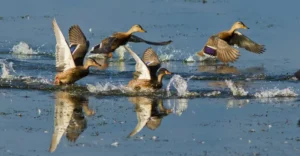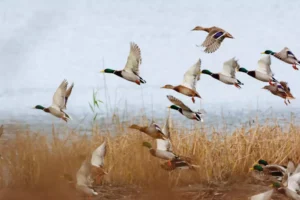Mallard ducks are one of the most widespread and recognized ducks in North America. They are also one of the most studied wild birds in the world. Mallards are thought to have originated from Asia, but they now inhabit nearly every continent.
In North America, mallards can be found in nearly every state and province during the breeding season. However, during the winter months, many mallards will migrate south to escape the cold weather.
Mallard ducks are one of the most common types of ducks in North America.
They can be found in nearly every state and province, and their range extends into parts of Mexico and Canada. Mallards are also a popular choice for domestic duck farming.
While mallards are permanent residents in many areas, they do migrate.
The timing of these migrations depends on the particular population of ducks, but generally speaking, mallards begin to head south in late fall as the weather gets colder.
They’ll often stay in southern states or countries until springtime when they’ll return to their breeding grounds further north.
There’s still a lot that scientists don’t know about mallard migration patterns. It’s believed that different populations of ducks may migrate at slightly different times or even use different routes.
And while some mallards do travel long distances during their yearly migration, others may only move a few hundred miles or less.
Whether you live in an area where mallard ducks are year-round residents or you just enjoy seeing them during their annual migration, these fascinating birds are sure to bring a bit of beauty and excitement to your day!

When Do Ducks Migrate?
When do ducks migrate? The answer may surprise you! Ducks are migratory birds, meaning they travel long distances between their breeding and wintering grounds.
Most species of ducks in North America migrate south in the fall to escape the cold weather. They return north in the spring to breed and raise their young.
Some ducks, like the mallard, can be found year-round in many parts of the United States.
But even these birds make short trips to find food or mates during different seasons. Migration is an amazing adaptation that helps ducks survive and thrive in a changing world.
Do Mallard Duck Fly South for Winter?
Mallards are a type of duck that is known to migrate south for the winter. It is believed that they do this in order to find warmer temperatures and more food.
While mallards can fly long distances, they typically only travel a few hundred miles at a time.
This means that they will often stop at various locations along their migration route in order to rest and feed.

What Time of Year Do Mallard Ducks Migrate?
Mallard ducks are one of the most common types of ducks in North America. They are also one of the most widespread, with a range that extends from Alaska and Canada all the way down to Mexico.
Mallards are highly adaptable birds and can be found in a wide variety of habitats, including ponds, lakes, rivers, marshes, and even urban areas.
While mallards don’t typically migrate long distances, they will move around seasonally in response to changes in food availability and weather conditions.
In general, mallards will begin migrating south in late fall as cold weather sets in and food becomes scarce. They’ll return north again in the spring as temperatures start to warm up and new sources of food become available.
So if you’re wondering when you’re likely to see mallard ducks in your area, it all depends on the time of year and where you live.
In northern regions like Alaska or Canada, mallards may start migrating as early as October or November.
But farther south in places like Texas or Mexico, they may not begin migrating until December or January. And of course, there’s always the possibility that some mallards will stick around all year long!
Do Mallard Duck Come Back to the Same Place Every Year?
Mallard ducks are one of the most common species of ducks in North America and are often seen in parks and other urban areas.
Many people assume that these ducks return to the same place every year, but this is not always the case.
Mallards are migratory birds and their patterns of movement depend on a variety of factors, including food availability, weather conditions, and nesting sites.
While some mallards may return to the same general area each year, others may travel much farther distances in search of ideal conditions. In any given year, it is impossible to predict where a particular mallard will end up.
Where Do Ducks Go in Winter?
When the weather starts to turn cold and the days get shorter, many animals begin to prepare for winter. Some migrate to warmer climates, while others hibernate. But what do ducks do?
Ducks are actually quite well-equipped to deal with cold weather. Their feathers are designed to insulate them against the elements, and they can generate extra body heat by shivering.
Ducks also have a layer of down feathers beneath their outer feathers that helps keep them warm.
So if ducks can withstand freezing temperatures, why do you so often see them in ponds and lakes during winter? The simple answer is that they need open water to survive.
While ducks can walk on ice and even swim in very cold water, they need access to open water in order to dive for food.
And since ponds and lakes tend to freeze over before rivers and oceans do, that’s where most ducks spend the winter months. Of course, not all ducks follow this pattern.
Some species of ducks live in areas where there is no risk of freezing temperatures, such as Australia or South America. Others migrate great distances to find suitable habitats.
For example, some North American duck species travel south all the way to Mexico or even Central America when winter arrives.
But whether they stay put or hit the road when the temperature drops, one thing is for sure: Ducks are tough little creatures that know how to adapt to whatever Mother Nature throws their way!
Why Do Ducks Migrate?
Conclusion
Mallard ducks are one of the most common types of ducks in North America. They are also one of the most popular types of ducks for hunting. Mallards are known for their distinctive green head and yellow bill.
The males also have dark brown bodies with white stripes on their wings. The females usually have light brown bodies with no stripes on their wings.
Mallards typically migrate in the fall, when they fly south to escape the cold weather in the north.
They will often travel in large flocks, sometimes numbering in the thousands. Mallards will often stop at ponds and lakes along their migration route to rest and eat.